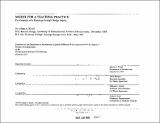| dc.contributor.advisor | Turid Horgen. | en_US |
| dc.contributor.author | Kisiel, Arlene A. (Arlene Ann) | en_US |
| dc.date.accessioned | 2011-12-09T21:16:09Z | |
| dc.date.available | 2011-12-09T21:16:09Z | |
| dc.date.copyright | 1997 | en_US |
| dc.date.issued | 1997 | en_US |
| dc.identifier.uri | http://hdl.handle.net/1721.1/67505 | |
| dc.description | Thesis (M. Arch.)--Massachusetts Institute of Technology, Dept. of Architecture, 1997. | en_US |
| dc.description | Includes bibliographical references (p. 254-256). | en_US |
| dc.description.abstract | This thesis examines the role of the architect in practice, specifically the architect's relationship with a health maintenance organization faced with the challenge of designing a model teaching practice. The primary goal of the project is to design a workplace that fosters communication and learning through interior architecture, work processes and organizational structure. In the study presented here, the architect becomes a researcher and explores a multiplicity of tools and techniques from various disciplines when engaging with participants of the professional community to learn about their space, work processes and organization . The participants are considered the experts of their workplace. Given this assumption, the architect listens to them, watches how they work, and interprets daily events in a personal log. In addition, the architect seeks for qualitative and quantitative data and prepares exercises that permit the participants to voice their ideas. The various forms of inquiry assist the designer in the reflective analysis and in the formulation of a conceptual framework for interior architecture, work processes, and organizational structure. Once completed, the designer creates a knowledge based design prototype that fosters the goals of the organization. This approach requires the architect to be multi-faceted. In addition to the traditional role as designer and consultant; the architect must act as a coach, analyst and synthesizer. One of my thesis goals is to demonstrate the potential for enriching the architectural design process through the application of various inquiry techniques coupled with reflection and discussion. The inquiry methods I employ include participatory observation, informal interviews, participant generated drawings and workbooks, and communication mapping. Using these environmental-behavior research tools reveals the paradoxes and inherent contradictions that exist within the organization and within the workplace. Once the conflicts are identified, a language or conceptual framework is developed which presents solutions to the problems. Finally, a proposal for a prototype is presented. | en_US |
| dc.description.statementofresponsibility | by Arlene A. Kisiel. | en_US |
| dc.format.extent | 256 p. | en_US |
| dc.language.iso | eng | en_US |
| dc.publisher | Massachusetts Institute of Technology | en_US |
| dc.rights | M.I.T. theses are protected by
copyright. They may be viewed from this source for any purpose, but
reproduction or distribution in any format is prohibited without written
permission. See provided URL for inquiries about permission. | en_US |
| dc.rights.uri | http://dspace.mit.edu/handle/1721.1/7582 | en_US |
| dc.subject | Architecture | en_US |
| dc.title | Model for a teaching practice : development of a prototype through design inquiry | en_US |
| dc.type | Thesis | en_US |
| dc.description.degree | M.Arch. | en_US |
| dc.contributor.department | Massachusetts Institute of Technology. Department of Architecture | |
| dc.identifier.oclc | 36944175 | en_US |
